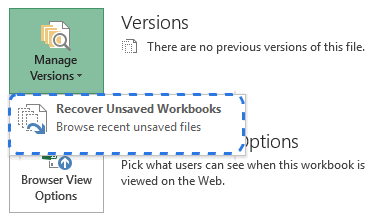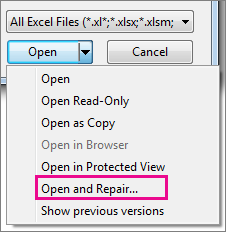

- #Recover previous version of excel file after saving windows 10#
- #Recover previous version of excel file after saving windows#
Once you recovered your temp files you can open the second type you can open directly with excel (since this actually is your original file).

Depending on the size of your drive this might take a long time. Here are some more information about the Excel AutoRecover Process that creates some of those files.įor recovery of deleted files you can use any decent recovery tool that does a "deep scan" of your drive e.g. With luck those files haven't been deleted yet, otherwise you need to recover them as well.
#Recover previous version of excel file after saving windows#
Third there are additional temp files that are saved in other directories used for storing temp files (depending on your windows and office/excel version). The tmp file (if it exists) is your last version of the excelfile, the other files are all sorts of previous versions (might be the last version or even older versions). These files are created and deleted due to the process how Excel saves files: instead of modifying your original file, Office it creates a new file and renames and deletes the old one containing the old version (tested with Office 365 V1909). is still intact) or 002322.xlsx (where the file's metadata has been deleted, in this case the filename) depending on various factors mainly on which excel file was saved last. The name might be something like F545F41.tmp (where the meta data of the deleted file, like filename, date etc. The file might have a different name/extension but file size will be exactly the one your previous version had (since it actually is your previous file). One that carry the same name then your original file with a ~$ in the beginning (the one that can see being created when you open it)Ī second type that you can only see when you recover deleted files on the drive where your excel file is located. Note, depending on the Excel version, there are several types of temporary files Excel creates in several locations which are deleted after you save your file and/or close Excel: If it's still there you might be able to restore your old file from there. That is assuming the data hasn't been overwritten by the OS for other/new files - to minimize that chance, this is important: you should stop using the drive your file is stored on (or if possible stop using the computer altogether). However, you might be able to recover it is through your (deleted) temporary files Excel produced. Solution to recover previous versions from temp files However you might be lucky since Excel produces several temporary files. Since the file and it's data in most cases has been overwritten unfortunately there are no other (easy) file recover options. You have done some type of backup which you can use to restore the file from You were using onedrive to save the excel file, then you can recover (e.g. see here), then and only then you can recover a previous versions (as you already discovered)


You activated Windows 10's File History which requires at least two drives (e.g. Now, you can select the directory where you want to restore the old version of the file.If you didn't recover the deleted temporary files right away (see solution to recover previous versions from temp files below), restoring your previous version most likely won't be possible unless previously: Alternatively, click the gear icon in the top right corner and select ‘Restore to’ from the drop-down menu. This overwrites the existing version of the file.
#Recover previous version of excel file after saving windows 10#
The optional File History feature in Windows 10 saves all files to a separate user directory on an external drive at regular intervals (and when you make major changes).


 0 kommentar(er)
0 kommentar(er)
